ITALY
Naples

Naples
Naples
Naples is the capital of the Italian region of Campania. It is the third largest municipality in Italy, after Rome and Milan. According to the 2012 census, about 960,000 people lived within the city limits. The Naples metropolitan area covers 1,023 square kilometers, with a population of 4 million. Naples is one of the oldest continuously inhabited cities in the world. The first settlements were established during the Bronze Age, by the Greeks from the island of Rhodes. The city played an important role in the introduction of Greek culture into Roman society and eventually became a cultural center of the Roman Republic. The port of Naples is one of the most important in Europe.
 NaplesPhoto: Damirux CC 3.0 Unported no changes made
NaplesPhoto: Damirux CC 3.0 Unported no changes made
Naples' historic city center is the largest in Europe, covering 1,700 hectares. In 1995 it was designated a World Heritage Site by UNESCO. In the vicinity of the city there are many interesting sights such as Pompeii and the Bay of Naples. Naples itself is a vibrant and bustling city, full of remarkable historical and artistic treasures and narrow, winding streets lined with small shops. The top sights are the Palace of Caserta and the Roman ruins of Pompeii and Herculaneum.
Location
The coordinates of Naples are 40 ° 50 'N latitude 14 ° 15' East longitude. Naples is located in the Campania region of southern Italy, not far from Rome, on the Gulf of Naples, between two volcanic areas: Vesuvius and Campi Flegrei. The port is the most important port in Southern Italy. The city is divided into 30 districts. The highest point in the city is only 17m. The islands of Procida, Capri and Ischia can be reached from Naples by hydrofoils and ferries. Sorrento is located south of Naples. The Roman ruins of Pompeii, Herculaneum and Stabiae are also a short distance from the city.
Weather
Naples has the benefits of the Mediterranean climate with mild, wet winters and warm, dry summers. The mild climate and fertility of the Gulf of Naples already made the region attractive in Roman times. The average annual high temperature is 20.4 ° C, the average annual low temperature is 10.4 ° C. The amount of rainfall per year is about 1006 mm. The average number of hours of sunshine amounts to 2,375 hours per year.
History
Naples has been inhabited since the Neolithic period. The earliest Greek settlements in this region date back to the 2nd millennium BC. Sailors from the Greek island of Rhodes established a small commercial port in the 9th century BC. The city developed around the harbor and grew rapidly as part of the powerful city-state of Syracuse. The Romans respected the city for its Hellenistic culture. During the later Roman era, the people of Naples retained their Greek language and customs. The city expanded further with the construction of luxurious Roman villas, aqueducts and bathhouses.
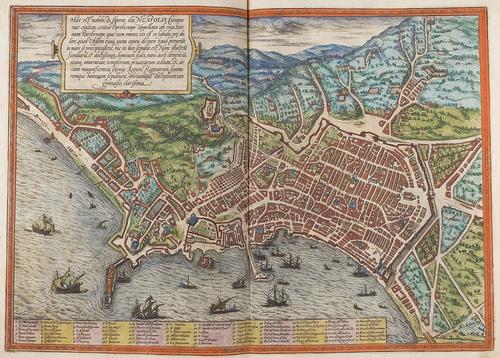 Naples Map from 1572Photo: Public Domain
Naples Map from 1572Photo: Public Domain
After the fall of the Western Roman Empire, Naples was conquered by the Eastern Goths and incorporated into the Ostrogothic Kingdom. The city's history was tumultuous with frequent changes of rulers. Naples gained complete independence in the early ninth century. In 1503 Spain recaptured Naples. After the Spanish victory, Naples became part of the Spanish Empire. This remained so during the Spanish Habsburg period.
In the 17th century, Naples was the third largest city in Europe and the largest European Mediterranean city with about 250,000 inhabitants. The city became an important cultural center during the Baroque period. In 1714, the Spanish rule of Naples came to an end. Naples became part of the Kingdom of Italy in 1861 during the Italian unification.
Naples is the most bombed Italian city during World War II and the first Italian city to stand up against the German military occupation. The city was liberated on October 1, 1943 when British and American forces invaded the city.
Sights
Naples has a wide variety of historic buildings and monuments from classical relics to medieval castles and palaces from the Renaissance and Baroque. The historic center of Naples has been declared a World Heritage Site by UNESCO. There are also 448 historic churches in the city. The main church is Naples Cathedral.
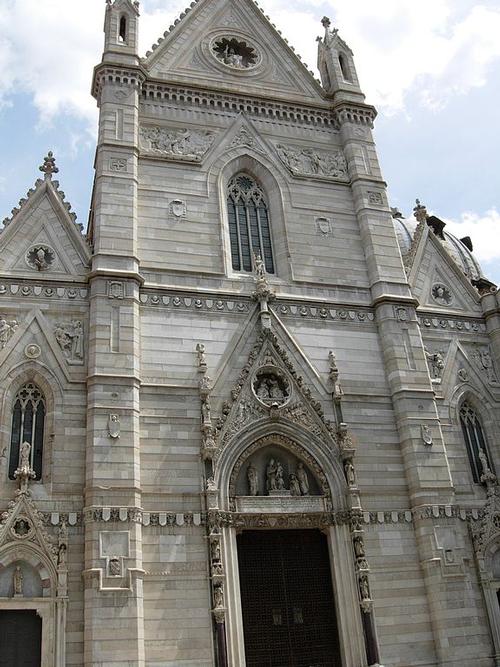 Duomo di San Gennaro NaplesFoto: Public Domain
Duomo di San Gennaro NaplesFoto: Public Domain
The simply enormous Duomo di San Gennaro is the city's cathedral and is without a doubt one of the most beautiful buildings in all of Naples. The church is built on the old site of a former cathedral from 570 AD (Cattedrale Stefania). Over the years, the Duomo has been restored and refurbished, especially after much of the church was destroyed by a major earthquake in 1456. Notable features include a gilded wooden ceiling (1621), gold medallions above the pillars with effigies of different saints, the Chapel of the Treasure of San Gennaro, built between 1608 and 1637 and many spectacular statues and frescoes.
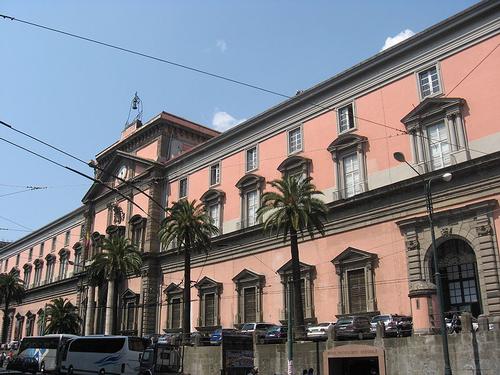 National ArcheologicalMuseum NaplesPhoto: Istvanka CC3.0 Unported no changes made
National ArcheologicalMuseum NaplesPhoto: Istvanka CC3.0 Unported no changes made
Naples is also known for its wealth of historical museums. The National Archaeological Museum of Naples is one of the most important museums in the city, with a very extensive collection of works of art from the period of the Roman Empire. It houses many artifacts excavated in Pompeii and Herculaneum as well as some artifacts from the Greek period and the Renaissance. Many of the items on display in this museum are part of the Farnese family's collection, which was built up over 300 years. On the first floor, room after room is filled with ancient sculptures, including some of the best extant copies of Greek statues from the Roman era. Upstairs, most of the rooms are devoted to finds from Pompeii and Herculaneum, near Naples, and the exhibits give a real insight into the lives of these people. Of particular note are some beautiful mosaics, with detailed comic scenes and images of battles. There are also numerous Roman wall paintings (the world's largest collection), portraits, fine art, frescoes, Greek vases, decorated bronze statues and an interesting model of all the excavations up to the 1840s in Pompeii.
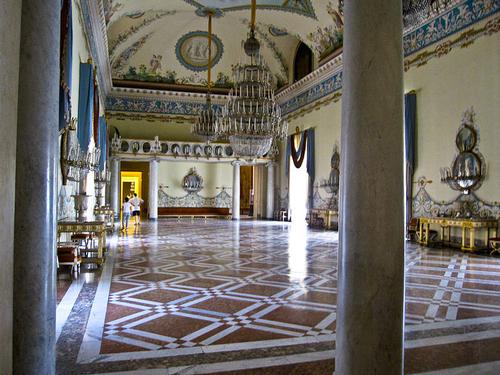 Museo di Capodimonteis NaplesPhoto: Armando Mancini CC 2.0 Generic no changes made
Museo di Capodimonteis NaplesPhoto: Armando Mancini CC 2.0 Generic no changes made
The collection of old masters and decorative arts displayed in the Museo Nazionale di Capodimonte is one of the best known in southern Italy and is particularly rich in late Renaissance works. Some of the artworks are of world class, such as 'Madonna' by Botticelli, 'Annunciation' by Filippino Lippi and many other works by leading artists. One room is completely filled with five great masterpieces painted by Caravaggio and other rooms are dedicated to Titian. An entire wing in this large museum is filled with over 3,000 18th century porcelain figurines, in another numerous 19th century watercolors are scenes of Naples and the countryside of the Campania region, they show the true beauty of this city, before the arrival of cars and traffic. There is also international contemporary art on display, including Andy Warhol's 'Vesuvius', painted when the famous artist visited Naples in 1985. The palace is located on top of a hill and offers spectacular views of Naples and the bay.
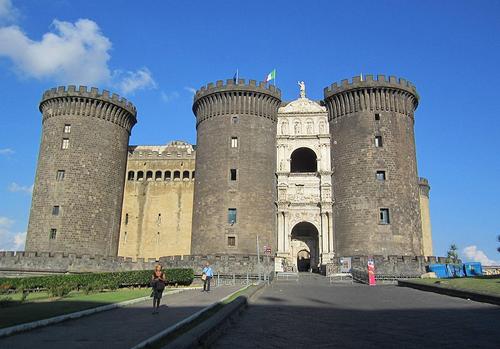 Naples CastelnuovoPhoto: Luca Aless CC 4.0 International no changes made
Naples CastelnuovoPhoto: Luca Aless CC 4.0 International no changes made
The Castel dell'Ovo is the oldest castle in Naples. The castle is located above the harbor and is used for exhibitions and concerts. The Castel Nuovo is a huge castle built in 1279-1282. You will see 14th and 15th century frescoes and paintings and silver and bronze artifacts from the 15th century to the present day.
 Teatro di San Carlo NaplesPhoto: Public Domain
Teatro di San Carlo NaplesPhoto: Public Domain
The Teatro San Carlo is known for its perfect acoustics and it is the best place to hear opera in Southern Italy. Opened in 1737, the Teatro is the oldest surviving opera house in the world. The theater was destroyed by fire in 1816 and rebuilt shortly afterwards. Inside, there are six levels with about 200 boxes and a huge podium with a unique backdrop that can be removed to reveal the gardens of the Palazzo Reale.
Tips
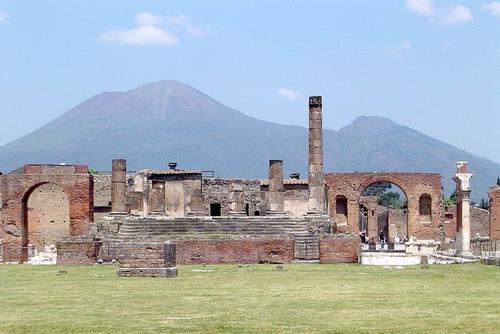 Naples PompeiiPhoto: Qfl247 CC 3.0 Unported no changes made
Naples PompeiiPhoto: Qfl247 CC 3.0 Unported no changes made
Naples is under the smoke of the volcano Vesuvius. When you visit Naples you must go to Herculaneum and Pompeii. You will get an unforgettable impression of life in Roman times. As a result of an eruption of Vesuvius in 79 AD, these cities were covered by a thick layer of lava and are therefore perfectly preserved. Today, Mount Vesuvius can be visited, grapes and olives grow in abundance on the rich volcanic soil and the area around the volcano has become one of the most densely populated in Italy.
Useful links Naples
BBC Country ProfilesWorld Fact Book Explore all Countries
How to call
Last updated November 2025
Copyright: Team - The World of Info